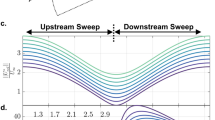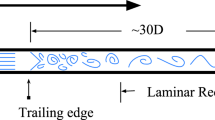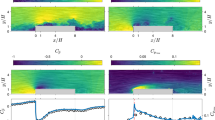Abstract
While PIV allows the extraction of instantaneous streamlines, the availability of typically thousands of patterns hampers a statistical understanding of the underlying flow topology. A particular application is oscillating gas jets, encountered in scientific and industrial studies dealing with mass transfer and flow control. Multiple methods, such as statistical moments (including mean, variance, skewness, and kurtosis), proper orthogonal decomposition (POD), and Hartigan’s dip test are common post-processing methodologies. However, as demonstrated in this paper, they do not provide sufficient in-depth information from a statistical perspective to attribute probabilities to potential flow topologies. In this work, a novel approach to describe probability distributions based on extracted streamline patterns is proposed. Based on the available streamline patterns, the convolution with adaptive Gaussian kernels reveals the probability density function of the flow topology. The proposed methodology, as well as more traditional post-processing approaches, are assessed on the basis of synthetic flow fields and experimental PIV data of oscillating impinging gas jets, demonstrating the added value of the streamline probability map in characterising the scrutinised flow.
Graphic abstract














Similar content being viewed by others
Notes
Hereafter, the methodology will be referred to by SPDF, while the probabilistic outcome is designated by the lower case letters \(\mathrm{spdf}\).
References
Basser PJ, Pajevic S, Pierpaoli C, Duda J, Aldroubi A (2000) In vivo fiber tractography using dt-mri data. Magn Reson Med 44(4):625–632
Berkooz G, Holmes P, Lumley JL (1993) The proper orthogonal decomposition in the analysis of turbulent flows. Annu Rev Fluid Mech 25(1):539–575
Brøns M (2007) Streamline topology: patterns in fluid flows and their bifurcations. Adv Appl Mech 41:1–42
Brudzinski MR, Thurber CH, Hacker BR, Engdahl ER (2007) Global prevalence of double benioff zones. Science 316(5830):1472–1474
Druault P, Guibert P, Alizon F (2005) Use of proper orthogonal decomposition for time interpolation from piv data. Exp Fluids 39(6):1009–1023
Hartigan JA (1985) Statistical theory in clustering. J Classif 2(1):63–76
Hartigan JA, Hartigan PM et al (1985) The dip test of unimodality. Ann Stat 13(1):70–84
Higuchi H, Zhang J, Furuya S, Muzas BK (1998) Immediate and near wake flow patterns behind slotted disks. AIAA J 36(9):1626–1634. https://doi.org/10.2514/2.564
Koklu M, Owens LR (2017) Comparison of sweeping jet actuators with different flow-control techniques for flow-separation control. AIAA J 55(3):848–860
Lumley J, Yaglom A, Tatarski V (1967) The inertial subrange in nonequilibrium turbulence. In: Yaglom AM, Tatarski VI (eds) Atmospheric turbulence and radio wave propagation. Nauka, pp 157–164
Mendez M, Raiola M, Masullo A, Discetti S, Ianiro A, Theunissen R, Buchlin JM (2017) Pod-based background removal for particle image velocimetry. Exp Therm Fluid Sci 80:181–192
Mendez M, Scelzo M, Buchlin JM (2018) Multiscale modal analysis of an oscillating impinging gas jet. Exp Therm Fluid Sci 91:256–276
Sheather SJ (2004) Density estimation. Stat Sci 19(4):588–597. https://doi.org/10.1214/088342304000000297
Simonini A, Theunissen R, Masullo A, Vetrano M (2019) Piv adaptive interrogation and sampling with image projection applied to water sloshing. Exp Therm Fluid Sci 102:559–574. https://doi.org/10.1016/j.expthermflusci.2018.12.016. http://www.sciencedirect.com/science/article/pii/S0894177718314109
Sirovich L (1987) Turbulence and the dynamics of coherent structures. i. coherent structures. Q Appl Math 45(3):561–571
Smith BL, Glezer A (2002) Jet vectoring using synthetic jets. J Fluid Mech 458:1–34
Taira K, Brunton SL, Dawson ST, Rowley CW, Colonius T, McKeon BJ, Schmidt OT, Gordeyev S, Theofilis V, Ukeiley LS (2017) Modal analysis of fluid flows: an overview. AIAA J 55:4013–4041
Tecplot, Inc (2018) User's Manual. Tecplot 360 EX 2018 R1
Theofilis V (2011) Global linear instability. Annu Rev Fluid Mech 43(1):319–352. https://doi.org/10.1146/annurev-fluid-122109-160705
Theunissen R, Edwards M (2018) A general approach to evaluate the ensemble cross-correlation response for piv using kernel density estimation. Exp Fluids 59(11):174. https://doi.org/10.1007/s00348-018-2627-8
Theunissen R, Scarano F, Riethmuller M (2008) On improvement of piv image interrogation near stationary interfaces. Exp Fluids 45(4):557–572. https://doi.org/10.1007/s00348-008-0481-9
Wang L (2010) On properties of fluid turbulence along streamlines. J Fluid Mech 648:183–203
Weber PT, Walrath DE (2017) Modeling noisy resonant system response. Mech Syst Signal Process 84:615–624
Xi HD, Xia KQ (2008) Flow mode transitions in turbulent thermal convection. Phys Fluids 20(5):055104. https://doi.org/10.1063/1.2920444
Yang N, Huang Y, Hou D, Liu S, Ye D, Dong B, Fan Y (2019) Adaptive nonparametric kernel density estimation approach for joint probability density function modeling of multiple wind farms. Energies 12(7). https://doi.org/10.3390/en12071356. https://www.mdpi.com/1996-1073/12/7/1356
Zuckerman N, Lior N (2006) Jet impingement heat transfer: physics, correlations, and numerical modeling. Adv Heat Transf 39:565–631
Acknowledgements
The authors would like to thank the China Scholarship Council for Dianfang Bi’s financial support (Scholarship no: 201806120081).
Author information
Authors and Affiliations
Corresponding author
Ethics declarations
Data access statement
All underlying data are described and provided in full within this paper.
Additional information
Publisher's Note
Springer Nature remains neutral with regard to jurisdictional claims in published maps and institutional affiliations.
Appendix: generating of synthetic flapping jets
Appendix: generating of synthetic flapping jets
Given a PIV recording of \(n_x\times n_y\) pixels\(^2\), the jet origin is positioned at \(\left( 1,\frac{n_y}{2}\right)\). The jet centerline is assumed to follow a parabolic trajectory \(y_c=ax_c^2+bx_c+c\). Imposing the centerline to be located at \(y_c=y_p\) for \(x_c=n_x\), with a horizontal tangent at the origin, the coefficients are given by \(a=\frac{y_p-\frac{n_y}{2}}{\left( n_x-1\right) ^2}\), \(b=-2a\), and \(c=a+\frac{n_y}{2}\). The arc length \(s(x_c)\) along the centerline can be calculated as \(s(x_c)=\frac{1}{4a}\left( f(2ax_c+b)-f(b)\right)\) where \(f(t)=t\sqrt{1+t^2}+\mathrm{log}\left( t+\sqrt{1+t^2}\right)\). The displacement along the centerline is prescribed as \(V_c(x_c)=8\left( 1+s(x_c)\right) ^{-0.5}\), i.e., a maximum displacement of 8 pixels in the origin is imposed. As the jet will spread out, the jet width is defined as \(\sigma (x_c)=\sigma _0\left( 1+\frac{5s(x_c)}{n_x}\right)\) with \(\sigma _0=10 pixels\). For any pixel location \((x_o,y_o)\), the normal distance, \(\eta\), to the jet centerline can be determined. Denoting the intersection point of the line, normal to the centerline and passing through \((x_o,y_o)\), and the centerline by \((x_i,y_i)\), the local, total velocity can be calculated as \(V_{tot}(x_o,y_o)=V_c(x_i)\exp \left( -\eta ^2/2\sigma ^2(x_i)\right)\). Local velocity components are then obtained as \(U(x_o,y_o)=V_{tot}(x_o,y_o) \mathrm{cos}(\theta )\) and \(V(x_o,y_o)=V_{tot}(x_o,y_o)\alpha \mathrm{sin}(\theta )\) with \(\mathrm{cos}(\theta )=\left( 1+(2ax_i+b)^2\right) ^{-0.5}\) and \(\alpha =\frac{2ax_i+b}{|2ax_i+b|}\).
Rights and permissions
About this article
Cite this article
Bi, D., Theunissen, R., Mendez, M.A. et al. Probabilistic evaluation of streamline topologies for the detection of preferential flow configurations in PIV applications. Exp Fluids 61, 13 (2020). https://doi.org/10.1007/s00348-019-2852-9
Received:
Revised:
Accepted:
Published:
DOI: https://doi.org/10.1007/s00348-019-2852-9




